Аннелиз Фрейзенбрук - Первые леди Рима
- Название:Первые леди Рима
- Автор:
- Жанр:
- Издательство:АСТ
- Год:2016
- Город:Москва
- ISBN:978-5-17-091449-4
- Рейтинг:
- Избранное:Добавить в избранное
-
Отзывы:
-
Ваша оценка:
Аннелиз Фрейзенбрук - Первые леди Рима краткое содержание
Образами римских царственных красавиц пестрят исторические романы, фильмы и сериалы — и каждый автор привносит в них что-то свое.
Но какими они были на самом деле?
Так ли уж развратна была Мессалина, так ли уж ненасытно жаждала власти Агриппина, так ли уж добродетельна была Галла Плацидия?
В своем исследовании Аннелиз Фрейзенбрук ищет и находит истину под множеством слоев мифов, домыслов и умолчаний, и женщины из императорских семей — умные интриганки и решительные честолюбицы, робкие жертвы династических игр, счастливые жены и матери, блестящие интеллектуалки и легкомысленные прожигательницы жизни — встают перед нами, словно живые.
Первые леди Рима - читать онлайн бесплатно ознакомительный отрывок
Интервал:
Закладка:
Roussin, L. A. (1994) «Costume in Roman Palestine: Archaeological Remains and the Evidence from the Mishnah», in Sebesta and Bonfante (eds.).
Santoro L’hoir, F. (1994) «Tacitus and Women’s Usurpation of Power», Classical World 88:5-25.
Sartre, M. (2005) «The Arabs and the Desert Peoples», in Bowman, Garnsey and Cameron (eds.).
Schmitt-Pantel, P. (1992) A History of Women in the West, Vol. 1: From Ancient Goddesses to Christian Saints. Cambridge, MA and London.
Schroder, V. (2009) «Re-Writing History for the Early Modern Stage: Racine’s Roman Tragedies», in Feldherr (ed.).
Sebesta, J. and Bonfante, L. (eds.) (1994) The World of Roman Costume. Madison, WI.
Setälä, P. (1977) Private Domini in Roman Brick Stamps of the Empire: A Historical and Prosopographical Study of Landowners in the District of Rome. Helsinki.
Setälä, P. (1998) «Female Property and Power in Imperial Rome», in Loven and Stromberg (eds.).
Setälä, P., Berg, R., Hälikkaä, R., Keltanen, М., Pölönen, J. and Vuolanto, V. (eds.) (2002) Women, Wealth and Power in the Roman Empire. Rome.
Severy, B. (2003) Augustus and the Family at the Birth of Empire. New York and London.
Seymour-Smith, M. (1995) Robert Graves: His Life and Work. London.
Sharrock, A. (1991) «Womanufacture», Journal of Roman Studies 81: 36–49.
Shaw, B. D. (1987) «The Age of Roman Girls at Marriage: Some Reconsiderations», Journal of Roman Studies 77: 30–46.
Shelton, J-A. (1998) As the Romans Did: A Sourcebook in Roman Social History. New York and Oxford.
Siegfried, S. (2001) «Ingres’s Reading — The Undoing of Narrative», in Siegfried, S. and Rifkin, A. (2001) Fingering Ingres. Oxford.
Smith, R. R. R. (1987) «The Imperial Reliefs from the Sebasteion at Aphrodisias», Journal of Roman Studies 77:88-138.
Smith, R. R. R. (1988) Hellenistic Royal Portraits. Oxford.
Spivey, N.J. (1999) «Introduction» to Robert Graves, The Claudius Novels. London.
Staley, A. (1965) «The Landing of Agrippina at Brundisium with the Ashes of Germanicus», Philadelphia Museum of Art Bulletin 61: 10–19.
Stout, A. M. (1994) «Jewelry as a Symbol of Status in the Roman Empire», in Sebesta and Bonfante (eds.).
Supple, J. J. (1986) Racine: Berenice. London.
Swain, S., Harrison, S. J. and Eisner, J. (eds.) (2007) Severan Culture. Cambridge.
Syme, R. (1984) «The Crisis of 2 BC», in A. Birley (ed.), Roman Papers, Vol. 3. Oxford.
Takács, S. A. (2008) Vestal Virgins, Sibyls and Matrons: Women in Roman Religion. Austin, TX.
Tamm, B. (1963) Auditorium and Palatium: A Study on Assembly- Rooms in Roman Palaces During the First Century BC and the First Century AD. Stockholm.
Tomei, M. A. (1998) The Palatine, trans. L. Guarneri Hynd. Milan.
Tougher, S. (1998) «In Praise of an Empress: Julian’s Speech of Thanks to Eusebia», in M. Whitby (ed.), The Propaganda of Power: The Role of Panegyric in Late Antiquity. Boston, MA.
Treggiari, S. (1973) «Domestic Staff in the Julio-Claudian Period», Histoire Sociale 6:241-55.
Treggiari, S. (1975) Jobs in the Household of Livia’, Papers of the British School at Rome 43:48–77.
Treggiari, S. (1991) Roman Marriage: Iusti Coniuges from the Time of Cicero to the Time of Ulpian. Oxford.
Treggiari, S. (2007) Terentia, Tullia, and Publilia: The Women of Cicero’s Family. London. Van Bremen, R. (1983) «Women and Wealth», in A. Cameron and A. Kuhrt (eds.), Images of Women in Antiquity. London.
Treggiari, S. (1996) The Limits of Participation: Women and Civic Life in the Greek East in the Hellenistic and Roman Periods. Amsterdam.
Van den Hout, M. P. J. (1999) A Commentary on the Letters of M. Cornelius Fronto. Leiden.
Varner, E. R. (1995) «Domitia Longina and the Politics of Portraiture», American Journal of Archaeology 99.2:187–206.
Varner, E. R. (ed.) (2001a) From Caligula to Constantine: Tyranny and Transformation in Roman Portraiture. Atlanta, GA.
Varner, E. R. (2001b) «Portraits, Plots and Politics: Damnatio Memoriae and the Images of Imperial Women», Memoirs of the American Academy in Rome 46:41–93.
Varner, E. R. (2004) Mutilation and Transformation: Damnatio Memoriae and Roman Imperial Portraiture. Leiden.
Vinson, M. (1989) «Domitia Longina, Julia Titi and the Literary Tradition», Historia 38:431-50.
Von Blanckenhagen, P. H. and Alexander, C. (1962) The Augustan Villa at Boscotrecase. Mainz.
Vout, C. (2007) Power and Eroticism in Imperial Rome. Cambridge.
Vout, C. (2009) «Representing the Emperor», in Feldherr (ed.).
Walker, S. and Higgs, P. (eds.) (2001) Cleopatra of Egypt: From History to Myth. London.
Wallace-Hadrill, A. (1988) «The Social Structure of the Roman House», Papers of the British School at Rome 56:43–98.
Wallace-Hadrill, A. (1993) Augustan Rome. London.
Wallace-Hadrill, A. (1994) Houses and Society in Pompeii and Herculaneum. Princeton, NJ.
Wallace-Hadrill, A. (1996) «The Imperial Court», in Bowman, Champlin and Lintott (eds.).
Walter, C. (2006) The Iconography of Constantine the Great: Emperor and Saint. Leiden.
Walton, C. L. (ed.) (1965) Berenice. London.
Whitmarsh, T. (2007) «Prose Literature and the Severan Dynasty», in Swain, Harrison and Eisner (eds.).
Winkes, R. (2000) «Livia: Portrait and Propaganda», in Kleiner and Matheson (eds.)
Winterer, C. (2007) The Mirror of Antiquity: American Women and the Classical Tradition 1750–1900. Ithaca, NY and London.
Wood, S. (1988) «Agrippina the Elder in Julio-Claudian Art and Propaganda», American Journal of Archaeology 92:409-26.
Wood, S. (1992) «Messalina, wife of Claudius: Propaganda Successes and Failures of his Reign», Journal of Roman Archaeology 5:219-34.
Wood, S. (1999) Imperial Women: A Study in Public Images, 40BC — AD68. Leiden.
Woods, D. (1998) «On the Death of the Empress Fausta», Greece and Rome 45.1: 70–86.
Wyke, M. (1994) «Woman in the Mirror: The Rhetoric of Adornment in the Roman World», in Archer, Fischler and Wyke (eds.).
Wyke, M. (ed.) (1998) Parchments of Gender: Deciphering the Body in Antiquity. Oxford.
Wyke, M. (2002) The Roman Mistress: Ancient and Modern Representations. Oxford.
Young-Widmaier, M. R. (2002) «Quintilian’s Legal Representation of Julia Berenice», Historia 51.1:124-29.
Zanker, P. (1988) The Power of Images in the Age of Augustus, trans. A. Shapiro. Ann Arbor.
Zarmakoupi, M. (2008) «Designing the Landscapes of the Villa of Livia at Prima Porta», in D. Kurtz, H. C. Meyer and E. Hatzivassiliou (eds.), Essays in Classical Archaeology for Eleni Hatzivassiliou 1977–2007. Oxford.
Zwalve, W. J. (2001) «In Re Iulius Agrippa’s Estate: Q. Cervidius Scaevola, Iulia Domna and the Estate of Iulius Agrippa», in L. de Blois (ed.), Administration, Prosopography and Appointment Policies in the Roman Empire. Amsterdam.
ИМПЕРАТОРСКИЕ ДИНАСТИИ
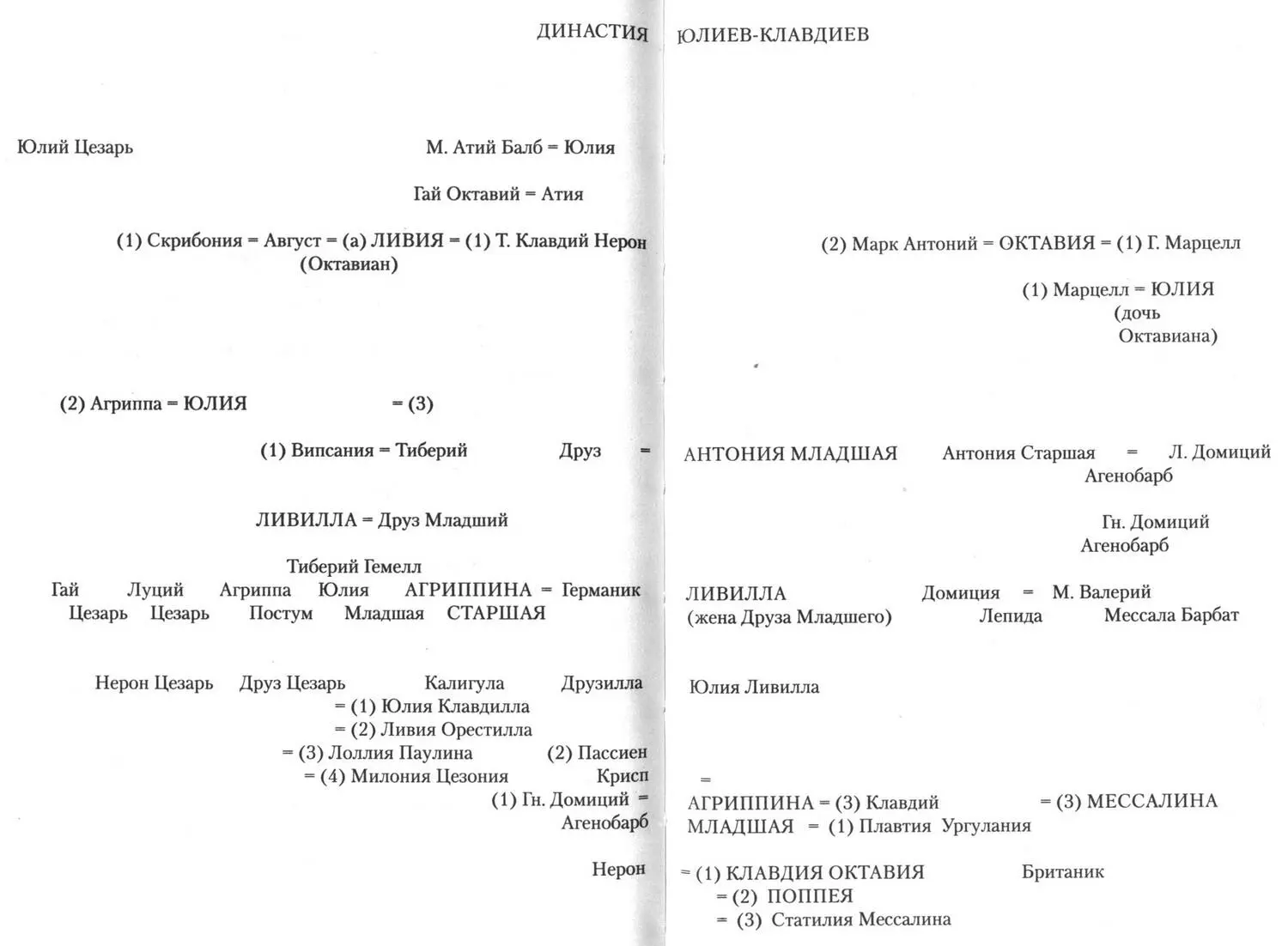
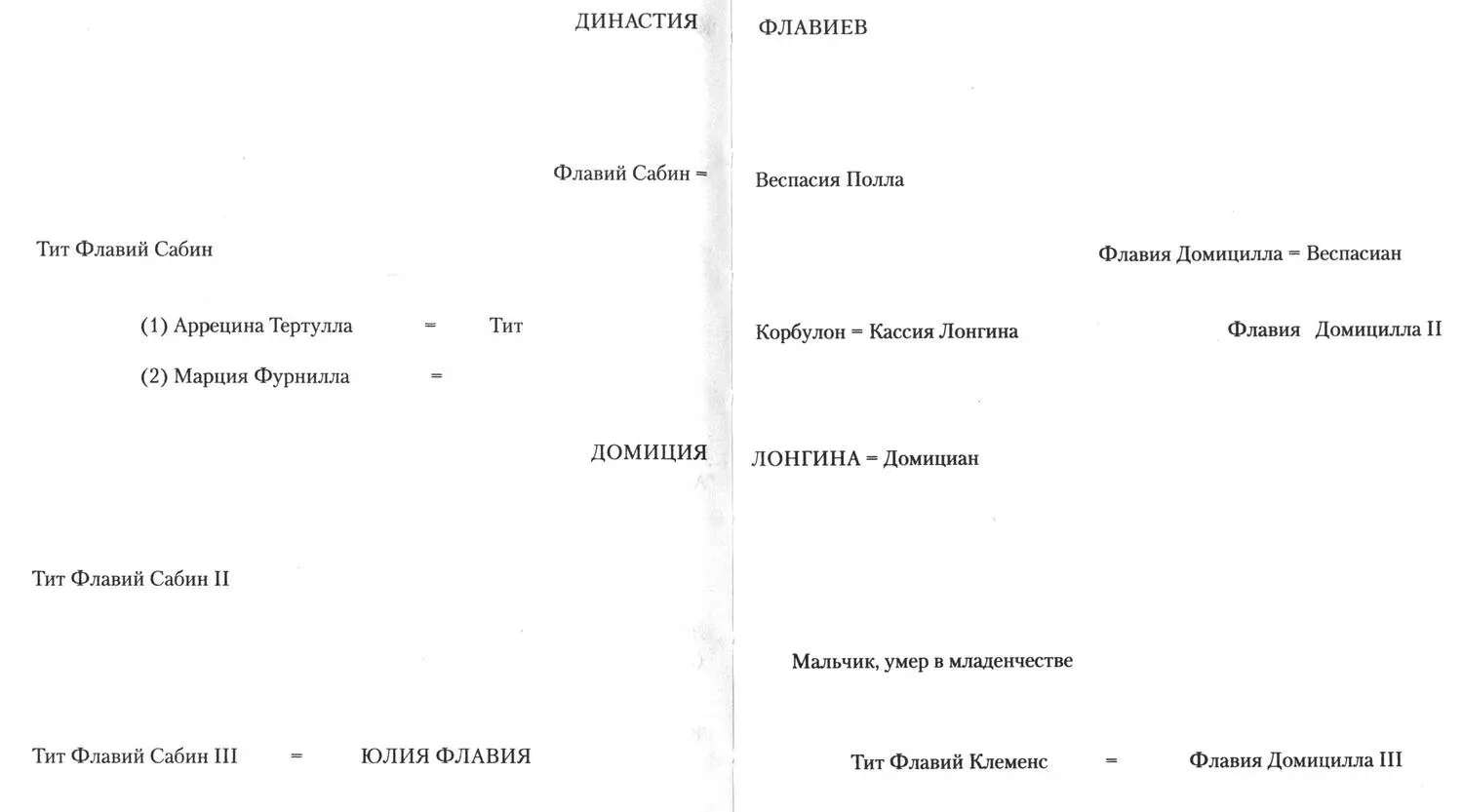


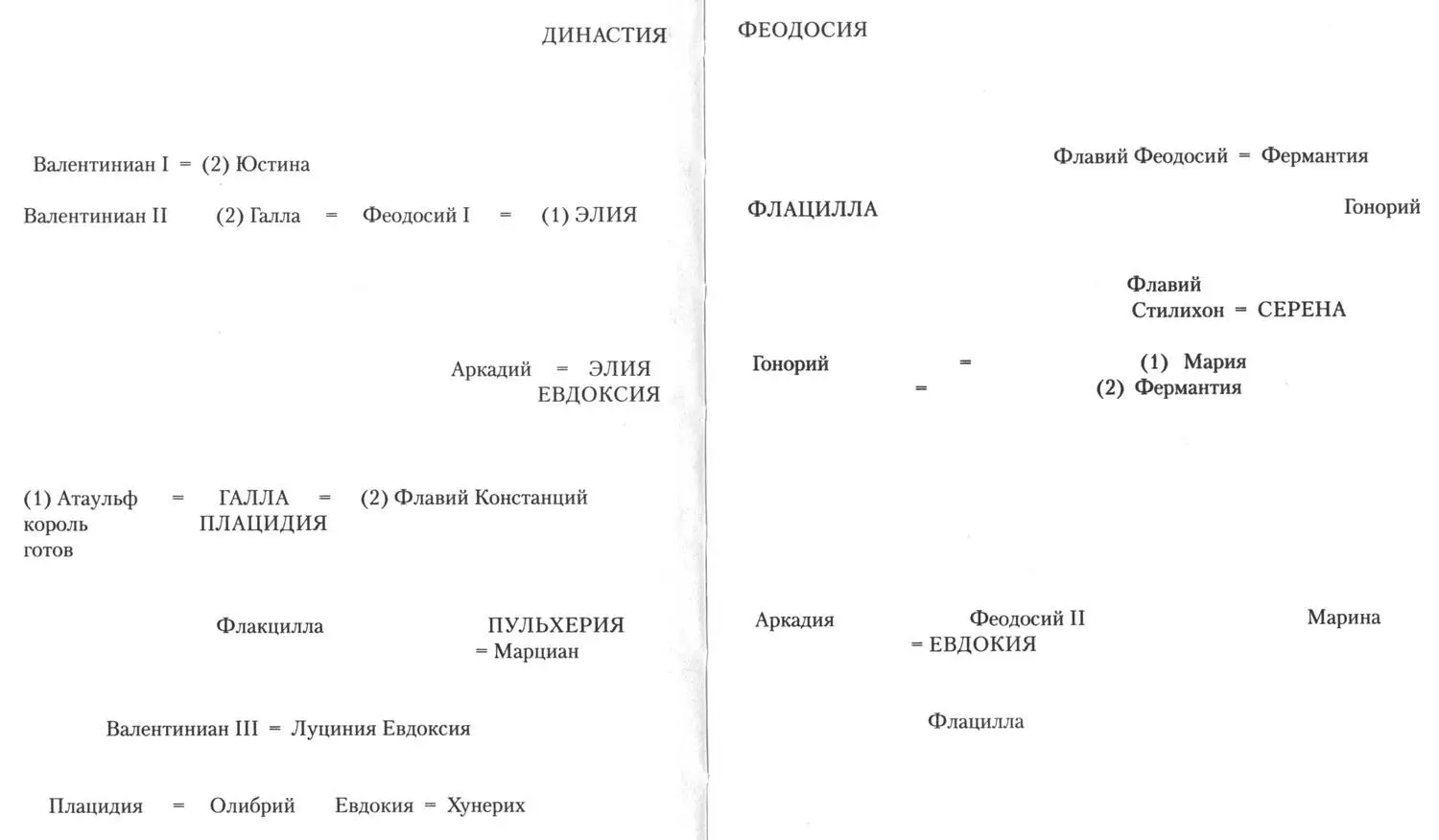
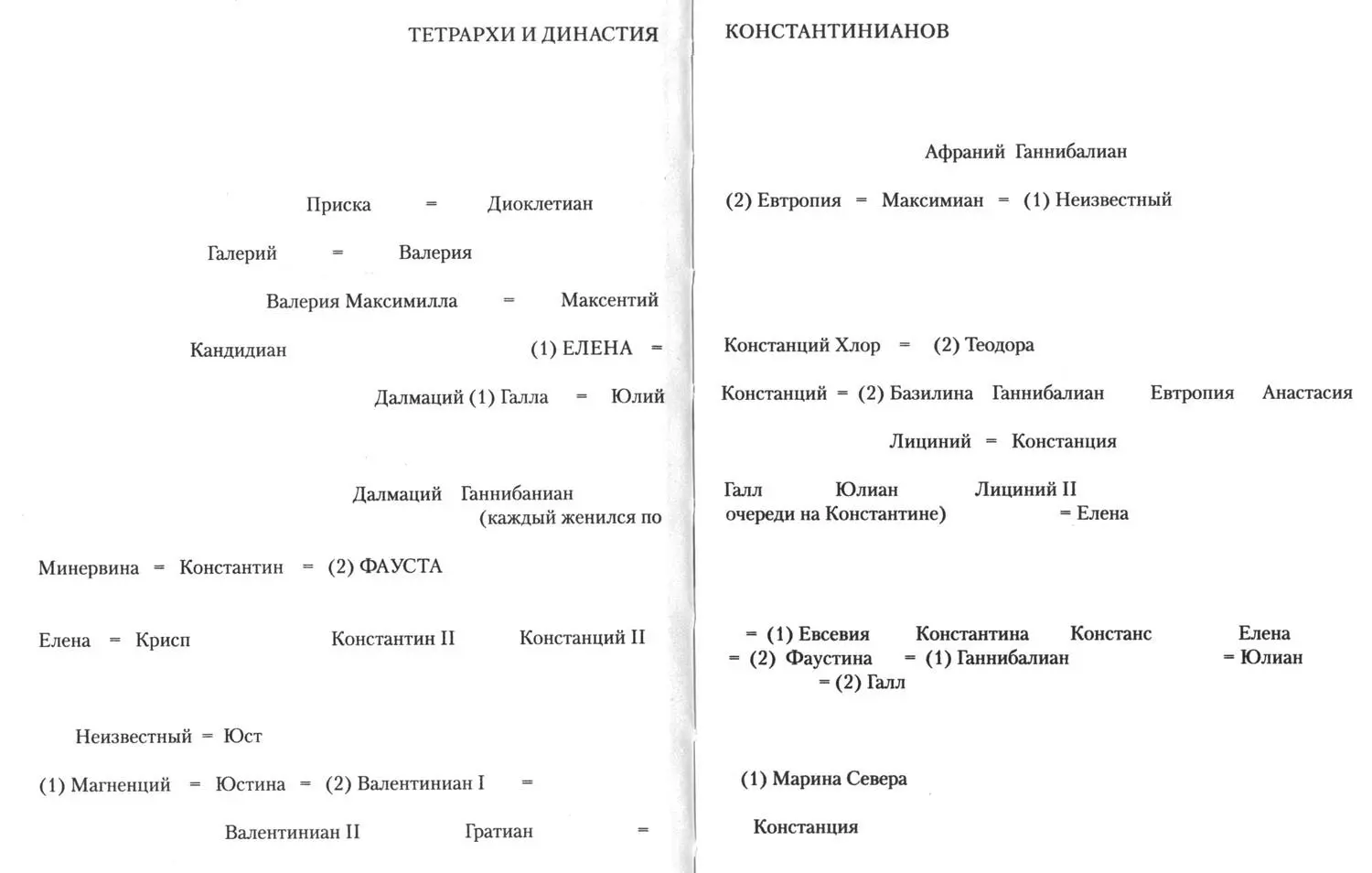
Примечания
1
В примечаниях мы перевели все ремарки автора, при этом указания на литературные источники (название книги и место в ней) постарались дать так, как они приведены в оригинале — на латыни, английском или других языках. Автор приводит здесь сокращенные обозначения источников; их развернутые наименования вместе с годом и местом выхода см. ниже, в списке литературы. (Прим. ред.)
Plutarch, Caesar 10.8. Миссис Ландингем, секретарь и консьерж президента, произносит эту фразу в эпизоде «18 и Потомак», вторая серия «Западного крыла».
2
О методе, которым читаются портреты императоров, см.: Vout (2009), 262. Этот бюст Фаустины Младшей является копией с оригинала: Vatican, Braccio Nuovo, 2195. Museum of Classical Archaeology, Faculty of Classics, Cambridge: no. 601.
3
О времени написания «Я, Клавдий», см.: Spivey (1999), vii, and Seymour-Smith (1995), 227-33.0 восприятии телевизионной драмы: Joshel (2001), везде, и 159, п. 35 — об изображении Ливии, в частности. И в книге, и в телевизионной версии мать Нерона именуется Агриппиниллой, чтобы отличить ее от матери Агриппины Старшей.
4
Джонатан Стамп, креативный директор «Рима», писал, что образцом для Атии стала Клавдия Метелла, матрона времен Римской республики, но в «Я, Клавдий» ясно распознаваем ее портрет. См. также: Ragalie (2007), 5–7. О признании Грейвзом влияния историков древности см. Spivey (1999), ix.
5
В 1893 году итальянский врач Чезаре Ломброзо и историк Гульельмо Ферреро — восемнадцать лет спустя написал историю римских императриц под названием «Женщины Цезарей» — опубликовали труд по физиогномике и патологии женской преступности, на обложке которого было помещено изображение бюста жены Клавдия, Мессалины. Авторы утверждали, что пропорции ее лица были такими же, как у проституток XIX века, см. Wyke (2002), 328-30.
6
О литературной традиции «достойных женщин» и их корнях в римской истории см. Winterer (2007), 41f; Hicks (2005а) и (2005b); McLeod (1991). О взгляде современных историков на Мессалину см. для более полного впечатления главы 9 и 10 в: Wyke (2002).
7
Интервал:
Закладка:
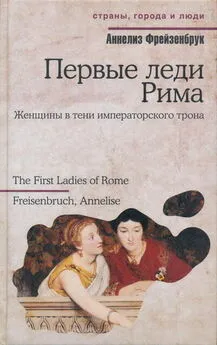


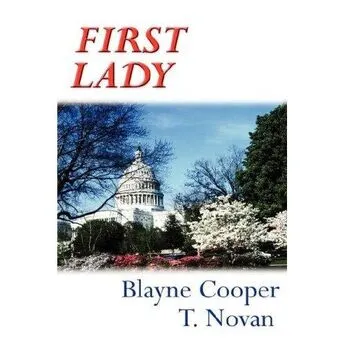


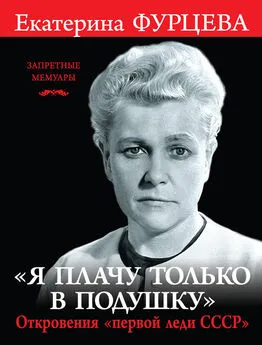


![Екатерина Фурцева - «Я плачу только в подушку». Откровения «первой леди СССР» [litres]](/books/1146768/ekaterina-furceva-ya-plachu-tolko-v-podushku-otkr.webp)
